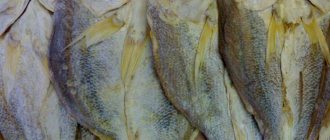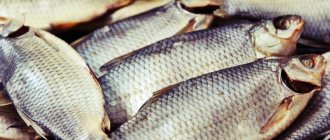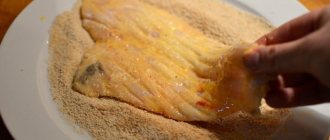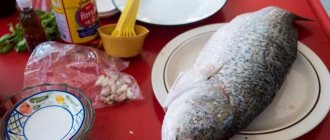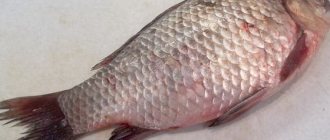Why is this necessary?
Methods for removing excess salt are suitable for fish that were salted at home, but something went wrong and the salt won, making the taste of the fish unnoticeable. When eating unsuccessfully salted fish, in addition to the taste, which few people may like, the salt content in it can have dangerous consequences for the body of someone who dares to eat a piece of over-salted product.
The question of how to soak fish often arises for fishing enthusiasts who want to taste their own caught and dried fish with beer. For these people, the question of how to soak salted fish before drying is especially relevant. Many salads and cold appetizers include lightly salted fish, because the strong taste of salt would necessarily make the salad simply an inedible set of foods.
Reviews
I put 1 kg of over-salted salmon fish in 2.5 liters of boiled water overnight and added 10 peppercorns, 1 small bay leaf, zest of the tip of a lemon (2 tsp) and 20 ml of vodka as a preservative. In the morning I took out the fish, dried it with a paper towel and coated it with odorless sunflower oil. The result was an amazing lightly salted fish with a light lemon aroma.
Before soaking the fish, you need to rinse it thoroughly under the tap in cold water. If the meat of the fish is dense (sockeye salmon, perch, cod, flounder, burbot), then the salted fish should be soaked for 5 to 10 hours. During this time, you should change the water two or three times. As far as I know, salted fish is usually soaked for as many hours as the number of days it has been salted.
The content of the article:
Dried fish is sold in many retail outlets, but to be sure of the quality of the product, it is best to make it yourself. To dry fish at home you don’t need to have any special skills; even a beginner can handle this simple process.
The taste of the finished product will depend not only on the cooking process. The quality of the finished product is affected by the size of the fish, fat content and fiber structure.
It is worth taking into account that drying is the process of drying fish carcasses with preliminary salting, which is mandatory for this method of preparation.
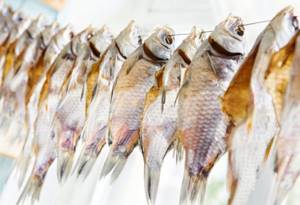
Is it possible to soak it?
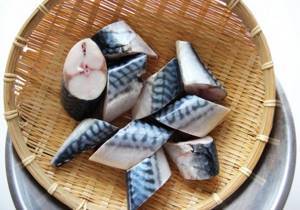
It turns out that there are actually many situations in which it would be useful to know about recipes and some of the nuances of properly ridding a product of excess salt by soaking it. So today we will figure out whether it is possible to soak salted fish and how to do it in a more correct way.
Let's start with the fact that a good appetizer of lightly salted herring, mackerel or red fish begins with strong salting. To destroy the microscopic parasites that are necessarily present in raw fish fillets, the fish is salted very hard. Residents of fishing places know everything about how to properly salt and how to soak highly salted fish.
How to check the doneness of fish

Before eating fish, you should check its readiness.
Signs of readiness:
- There are no salt residues on the surface of the carcass, and the meat becomes translucent.
- The finished fish should bend easily (the tail should touch the head). The carcass should spring back and easily return to its original state. The dried fish is wrapped in a wet rag and placed for 12 hours in the cellar or on the refrigerator shelf.
- Before eating, the fish is placed in a cool and ventilated place to ripen for a period of 2 to 3 weeks.
- The finished product can be stored in the kitchen cabinet. In this case, it is carefully wrapped in parchment, film or foil.
- It can also be placed in a bag and hung in a drafty room or placed in a willow basket with a tight lid. The basket should be placed in a dark, ventilated room.
At first, I became interested in the Internet on forums. They told us how to soak fish in milk and vinegar. I tried it. Neptune knows him, maybe the milk is not the same, maybe only a certain type of fish can be combined with it, but not the same taste, for the life of me. I’m generally silent about vinegar. Herring with onions and vinegar on the table is a wonderful appetizer, but it doesn’t work with sorog, dace or perch. I wouldn’t want to seem picky, but for a native Angarian... it’s creepy.
I settled on the simplest and, as it turned out, effective method - soaking in water and periodically replacing it completely. For you who are faced with this issue for the first time, I’ll tell you straight - don’t expect that you will get what you want the first time. The taste and color...you understand. You will have to go through this procedure two or three times until you get fish with the required salt content that suits your taste.
What's the salt?
It is possible and even necessary to rid fish of excess salt. This way you will save your health. This seasoning is quite harmful and even dangerous if you do not use it in moderation for human nutrition. Here's how salt negatively affects the organs and condition of those who neglect caution:
- it irritates the mucous membranes of the entire digestive tract;
- is a catalyst for increased excretion of calcium from the body, resulting in bone fragility;
- increased salt consumption contributes to swelling of the hands, feet, and face;
- salt can be deposited in joints and act from the inside, destroying them and causing pain to a person;
- Problems with blood vessels and the heart are most likely to occur among lovers of excessively salty foods, which greatly contributes to increased blood pressure.
And this is not the entire list of possible problems. Therefore, returning to the question of how to soak salted fish, let’s proceed straight to the recipes.
Lightly salted, but oversalted
Lightly salted fish is the most common dish at Russian feasts. But what to do if the fish turns out to be over-salted?
The most delicious fish is lightly salted. This dish is prepared by soaking. A few simple secrets will help you achieve the most pleasant and delicate taste.
Fish meat acquires good taste precisely after getting rid of excess salt. But it should not only be tasty, the benefits and safety are also important, and this is why pre-salting is required.
To correct the situation you will need:
- scissors, knives, board;
- marinade;
- dishes with lid;
- seasonings;
- and of course the fish itself.
The over-salted fish needs to be cut and cut into portioned pieces, after which the meat is placed in a bowl and poured with a tasty marinade (unsalted). The fish dish should be kept for 2 – 6 hours. Before serving, try it, maybe you need to sprinkle the meat with lemon juice or blot it a little in a paper towel.
Preparation for the process
To carry out the soaking procedure comfortably, let’s first make sure that these tools and their complementary elements are available:
- Tools and utensils for more comfortable processing and cleaning of fish. This list necessarily includes a cutting board, knives, and scissors.
- A container with a lid. Use any suitable and clean container: basin, bucket, pan, tank - all of this will do. Select the volume of dishes for soaking in accordance with the amount of fish you are going to process.
- Soaking solution (prepare yourself).
- A variety of spices for fish.
- The culprit of the whole process is over-salted fish.
It is better to cut a large fish carcass into pieces: this way more salt will come out of it.
Which fish is best to dry?
Most often, small fish are used for drying, which are useless to bake or fry. Larger specimens are usually prepared in other ways, but this does not mean that they are unsuitable for drying. It is better to dry fresh fish that was caught no more than a day ago.
Types of fish suitable for drying:
- silver bream;
- vobla;
- crucian carp;
- roach;
- bleak;
- ide;
- white bream;
- pike;
- saberfish;
- capelin;
- perch;
- rudd;
- zander;
- mackerel;
- bream;
- carp.
Catfish and burbot are very fatty, and for this reason they are difficult to process. But people with experience manage to dry these types of fish. Goby and rotan are also not entirely suitable for drying, since in the process the mass of the fish decreases several times, and there is practically nothing to eat there.
Fatty varieties are the most delicious, but do not last long, and very quickly acquire the smell of spoiled fat and an unpleasant aftertaste. This fish is dried in small quantities and eaten quickly. For long-term storage, it is worth choosing leaner fish species.
The meat of predatory fish is considered practically dietary and is ideal for drying. White fish (siberian fish, bream, silver bream, and others) are suitable for preparing taranka, but its fat content depends on the time of year. Sometimes it happens that fat drips from suspended fish.
Cold water (the cheapest method)
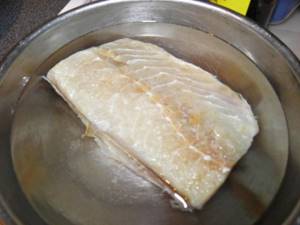
But we will start with the simplest and most accessible method for those who are puzzled by the question of how to quickly soak salted fish. Water is what will help make the very salty fish more enjoyable and healthy. There is an opinion that you need to soak fish for exactly the same amount of time as it was salted. But, probably, rarely does anyone know the exact number of hours or days during which the fish remained in salt before coming to us for processing. Therefore, we use classical technology.
First of all, let's rinse our fish in cold water. Then put it in a suitable container and fill it with cold water. During the process, it is better if the dishes with the fish are in the refrigerator. It is necessary to change the water to fresh water every two hours. Do not neglect this small rule, then the fish will have a more pleasant taste. Salted fish is very heavy, which is why it will initially sit at the bottom of the bowl with cold liquid. After some time, when salt begins to come out of it, the fish will feel better and will rush to the surface. When the soaked fish floats to the surface, it means the process was successful.
However, there are times when you need to soak a lot of fish. In this case, a large tank and cold water from a well or pump will do (if the process takes place in conditions close to natural). The container must be installed in a cool place so that the sun's rays never find your fish stock. For five kilograms of salted fish, use ten liters of water. Change the water every two hours. And to lower its temperature, pour ice into the bowl with the fish.
Stewed, fried or boiled fish
- One option is to serve the fish with an unsalted side dish. Non-salted mashed potatoes, vegetables, and rice are perfect;
- If you have ready-made, but already over-salted fish, you can make another dish, for example, a delicious fish pie. You can also add rice to it. At the same time, there is no need to salt the dough and rice;
- Fish stewed in flour, sour cream, sour sauce will also help get rid of over-salting;
- You can also stew the fish with unsalted ready-made mashed potatoes or plain potatoes;
- Rice has an excellent ability to absorb salt. Therefore, a small amount of rice can be cooked together with over-salted fish for 30 minutes. This method is also suitable for over-salted soup; rice (tied in cheesecloth) needs to be cooked in the finished soup or even added as an ingredient.
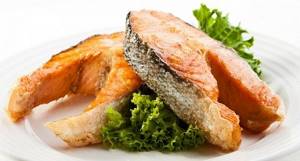
If you have over-salted the finished fish, you should not throw it away.
There are ways to help fix this. Leave feedback
Spicy salted fish
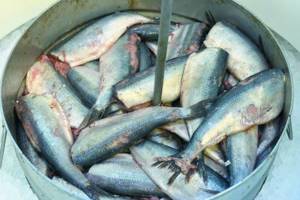
You can fix fish that has been over-salted in a spicy brine using water and vinegar. Please do not confuse vinegar and vinegar essence. Before preparing the solution, make sure that you have table vinegar.
For 10 parts water you need one part vinegar. Add some fish spices and place the salted, spicy-salted fish into the prepared marinade. Do not cut the carcasses, leave them whole. Place the dish with fish in the refrigerator for several hours. Usually five to six hours is enough. After this time, the fish becomes less salty.
We correct shortcomings
This method certainly has them. The more tender and fatty the fish, the more watery its meat will be after soaking. Therefore, pay attention to several other ways that can save the product:
- Cut the fish into pieces and place in cold, strong tea for several hours. The downside will be the specific taste and aroma of tea.
- Herbal decoction. This method will be almost identical. But the final product, or rather its taste, will depend on the herb chosen. Mint, sage and lemon balm are best suited for these purposes.
- Lemon juice. The fastest way, which is useful for those who are thinking about what to do with over-salted fish. Cut it into small pieces and pour lemon juice diluted with water in a ratio of 1:3. It makes an excellent snack that can be complemented with boiled potatoes.
- Milk. The fish should be placed in regular milk for 3 hours. After this, it will acquire a completely normal taste.
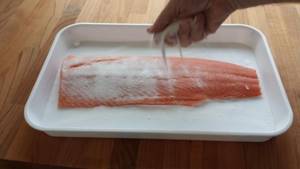
Smoked fish

Sometimes it may be necessary to remove excess salt from finished smoked fish. How to quickly soak smoked salted fish in such a situation?
Step one. Place the fish in a small container (with a lid). Prepare a solution to rid it of excess salt. You need to take equal quantities of cold water and cold fresh milk.
Step two. Pour this mixture over the fish and put it in the refrigerator for half an hour. In thirty minutes you will have a wonderful, not too salty smoked fish. Be sure to rinse it with cold water and pat dry with paper kitchen towels.
Methods for soaking salted fish
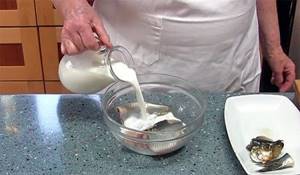
There are several techniques for soaking fish. The technology depends on the quantity of fish, the type of fish and the taste, as well as the taste preferences of the housewife.
You can soak fish as follows:
- The simplest and most affordable way is soaking in plain water.
- In milk.
- In tea.
- In marinades prepared according to special recipes.
- Industrially, when the fish is soaked under running water.
When soaking fish, you should always remember that additional operations worsen the taste of the product. Therefore, the process must be deliberate and moderate.
red fish

Salmon are the types of fish that are desired on the holiday table. Due to their unmatched taste and nutritional content, they are very popular among housewives. And since this fish is not cheap, the soaking methods are not simple. The main task is not to spoil the dish.
A variant of this preparation:
- Red fish is cut, sometimes into fillets, and cut into pieces.
- A marinade is prepared with the addition of spices, cherry syrup, vinegar, etc. The marinade needs to be boiled.
- The fish is placed in the hot marinade.
- After everything has cooled, the fish is washed and again filled with marinade, strained through a sieve.
- Fish can remain in the marinade for up to several days. At the same time, it should be in a cool place (in the refrigerator).
There are recipes in which fish is soaked in tea, sometimes with sugar, with the addition of vodka and cherry syrup.
No less common is the method of soaking fish in milk. As a result, the fish meat becomes tender and pleasant to the taste. To do this you need:
- Buy fresh milk at the store.
- Place it in the refrigerator for a while.
- Place the fish in a container.
- Pour cold milk completely over the fish.
- Place the fish in the refrigerator for a certain time.
The fish is soaked for a certain time, depending on the degree of salinity. For example:
- A large carcass, which was cooked in a high concentration of salt, can be soaked from one to five days.
- It is enough to keep medium-salted fish in the solution for several hours.
- If you need to quickly rid the fish of excess salt, it is better to place it in hot water or marinade.
Slicing red fish or how to make salted fish not salty
Spicy salted fish
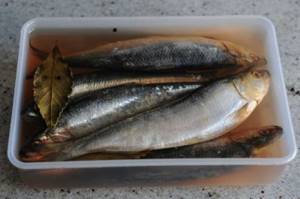
Spiced salted fish is fish when spices are also used during the salting process. Using this technology, ordinary herring, mackerel, and pink salmon are salted. Such fish is soaked either in water or in milk.
Soaking technique:
- It is necessary to take a container in which the fish fits completely.
- Water is poured into the container with vinegar added in a ratio of 10:1. The solution should not be very sharp and not fresh.
- The fish is placed in a container.
- After this, it is placed in the refrigerator for several hours.
You can soak fish in strong tea:
- The fish is cut into pieces of the required size.
- A container of the required size is prepared.
- Strong tea is poured into it, with the addition of sugar or syrup.
- The fish is placed in tea and placed in the refrigerator for several hours.
The method of soaking in tea has its advantages. Due to the presence of tannins in it, the fish does not lose its beneficial qualities.
Dry fish
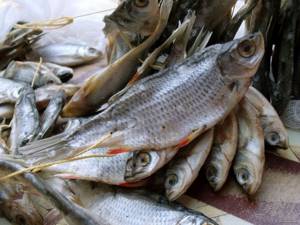
The question of whether it is possible to soak dry salted fish will have a positive answer. Of course, dry fish in most cases is used as a pleasant snack with beer, but a huge amount of salt can ruin the entire impression of such a snack. How to rid such a fish of a large amount of salt if necessary? Most often, such fish are soaked in water to loosen its meat. Then, when the fish is saturated with water, it is placed in cold milk for several hours. The degree of salinity is easy to check. Just remove the fish from the milk, rinse and taste. If the amount of salt has reached the standards that suit you, feel free to remove all the remaining fish from the container and, after rinsing with water, you can use it for its intended purpose.
Fish on a coat
First of all, try a piece. If the salt is very strong, then you will have to save the situation as follows. Cut the fish into pieces and sprinkle with lemon juice. You can add a little pepper. Now set the fish aside temporarily. Today we will look at several options for what to do if the fish is over-salted, among which you can choose the one you like best.
So, the fish is soaked in juice, and we prepare the vegetables. Fry a fairly large amount of onions and carrots in vegetable oil. You don't need to salt the vegetables to compensate for the excess salt in the fish. Pour lemon juice over the vegetables and add a little sugar. You can also sprinkle the fish with a little sugar. Now place vegetables and fish in layers in a saucepan, then heat for 5 minutes. Vegetables will remove excess salt.
A noble way for noble fish
Red fish must be pre-prepared. Remove the head, fins and other inedible parts. Cut it into pieces. You can only use the removed fillet.
Add suitable spices to the container for soaking the fish. Their number is a purely individual matter. It is also recommended to add cherry syrup to taste and vinegar (not essence) to the marinade. The marinade without salt should be boiled and cooled slightly. Pour the hot liquid into the bowl with the fish.
The cooled marinade is drained from the fish and filtered. The fish is washed in cold water and placed again in a clean container. Pour in the resulting and strained marinade. In a few hours, a wonderful lightly salted red fish is ready for your table.
Salting fish before drying
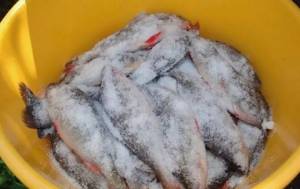
You should not start salting fish immediately after catching. You should top it with nettles and place it in the refrigerator for several hours.
In summer, all fish, even predatory ones, feed on grass. If the insides are not removed from it, then after a few hours decomposition processes will begin and it will become unfit for consumption.
Do not forget that raw fish is a source of pathogens and worms. It can be consumed only after heat treatment or two weeks of pickling.
You can use dry salting, or use brine.
Let's take a closer look at how to salt fish in brine:
- It is necessary to choose a container made of material that will not oxidize, such as food grade plastic or metal. You cannot use containers coated with zinc. It should be kept in a cool place.
- Place the fish tightly in one or more rows.
- Place a lid on the last row of fish and press down on top with pressure. With its help, you can compact the fish and prevent the formation of air chambers, where colonies of putrefactive bacteria most often settle and begin to develop.
- Prepare the brine. To do this, take 3 liters of water and 250 g of salt. If necessary, the volume of components is increased.
- After the salt has completely dissolved in the water, the brine is poured into the container where the fish lies under pressure.
- Sometimes sugar is added to brine. For 1 kg of salt use no more than one tablespoon.
Sometimes it becomes necessary to salt fish directly at the place of catch. For this purpose, use a thick bag, which is placed in the shade. They put pressure on the fish and fill it with brine. The top of the bag is not completely closed, but rolled up.
Typically, specimens that reach 1 kg or more are dried using dry salting. Wooden boxes, baskets or other containers are suitable for this purpose. It is very important that there are holes at the bottom for liquid drainage.
First, clean burlap or cotton fabric is placed on the bottom.
Then lay out the fish carcasses and sprinkle with coarse salt. It should be taken into account that during salting the fish will release liquid, which must drain. Each carcass is placed belly up and salted inside.
Sometimes fish are salted in this way directly in bags, which are placed in a meter-deep hole and buried. The fish will be saturated with salt, and the low temperature will prevent the product from deteriorating.
Salting time is from 3 to 5 days.
The duration of soaking should be at least 12 hours, but some fishermen believe that this stage should last as long as the fish was salted.
Water must be changed every 5-6 hours.
Method two (ignoble)
If you have over-salted red fish in your house, use this recipe to rid it of excess harmful salt.
So, how to soak very salty fish?
Place the fish fillets or pieces in a container. Pour cold kefir over the fish. Please note that kefir should be taken as fresh as possible. Place the fish in kefir in the refrigerator overnight (8 hours). In the morning, it will be enough to rinse it and you can use it for its intended purpose.
Sometimes, instead of kefir, it is recommended to fill red fish with whey. Housewives believe that kefir and whey remove salt from this fish more effectively. And there’s less fuss - you put it in, pour it in, take it out, rinse it and enjoy!
How to dry fish at home
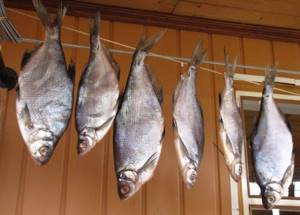
Let's take a closer look at all the processes on how to properly dry fish at home.
For drying, the fish must be hung. This can be done in two ways: by the tail or the head. A hole is made in the tail using a knife. This hole is used to attach the hook. In this position, all excess moisture from the abdomen flows out through the head. Thanks to this, the meat does not become bitter.
If the carcasses are hung by the heads, then a rope or wire is passed through the eyes. With this method, the fat will remain inside, and the meat will be slightly saturated with bile. As a result, the taranka will acquire a slight bitterness, which is appreciated among beer lovers.
The fish is hung on a rope made of natural materials, or a wire made of stainless material. During the drying process, carcasses should not touch each other.
Most often, the fish is first hung out in the sun to dry for 5-6 hours. Near this, garlands with fish are placed in a place where there is shade and a draft. If the weather is good outside, the fish dries out in three or five days.
If the air is too humid, then several transverse sticks are placed inside each carcass. This will allow the fish to dry faster.
The ideal place for drying fish is an attic with open windows. The fish will dry most quickly at a temperature of +18 to +20 C.
The places for drying fish are as follows:
- Attic.
The roof surface always warms up well. The carcass is not affected by either rain or sun. - Oven.
First, the carcasses are heated in the oven for 2 hours. After this, each head is covered with foil, and the fish is left in the same conditions. After this, the fish is hung on the balcony, and the process continues for several more days. - Electric dryer.
To prevent the fish from steaming and falling apart, you should not raise the temperature above 30°C. - On open air.
Fish can only be dried in warm and sunny weather. When it rains or at night, the fish are removed indoors. - On the balcony.
Such a room is suitable for drying even in damp weather. It is very important to lay the floor and open the windows before starting the process.
Sometimes they start hanging fish out to dry late in the evening so that they have time to dry a little. This way it attracts fewer flies.
There are fishermen who hang fish only in the sun during the day and bring them indoors at night. They claim that as a result of temperature changes, the fish becomes damp and loses its taste.
Also, sometimes the ram is hung in cool and damp weather. If it is well salted, it will not spoil. But under such conditions, the meat will dry out longer, but the taste of the fish will be much juicier and better.
Each carcass can be smeared with crushed garlic.
Lubricate the fish heads with sunflower oil.
After the fish have been soaked, the carcasses are dipped in an acetic acid solution for 5-10 minutes. For 10 liters of water give 6 tablespoons of vinegar. This will repel insects, but at the same time reduce the taste of the ram.
The garland with fish is covered with gauze. This must be done so that the flies do not get to the fish. The gauze canopy is also sprinkled with vinegar or smeared with garlic.
In one container, mix vinegar (one part) and sunflower oil (three parts). This composition covers the surface of each carcass.
Soaking in water
You will need:
- vinegar 70%
- salted herring
The fish is immersed only in cold water. If it is hot outside, it is advisable to keep a container of water in the refrigerator. The liquid that has absorbed salt should be changed every 2-3 hours. If in summer it is not possible to put the fish in water in a cold place, then try to change the water every 1.5–2 hours, or even more often, otherwise the herring will quickly spoil.
To speed up the soaking process, add 70% table vinegar to the water in a ratio of 10 parts water to 1 part vinegar.
If the salted fish floats up, then it has lost enough salt. Its taste has become much more pleasant and tender. When left in water for a long time, the pulp will absorb liquid, increasing the weight of the product by 5–20%.
Alternatively, slightly salted herring can be placed in a colander and placed under running tap water. This will prevent it from absorbing a lot of water. Rinse it for about an hour, turning it over periodically.
Soaking after salting
If the fish was salted at home using a dry, brine or hanging method, then this procedure is required.
For the rest, before drying, you can simply rinse it (if necessary) under running water.
Soaking instructions.
- For convenience, sort the carcasses by size.
- Large fish are soaked for 1.5 - 2 days. In this case, it is necessary to change the water three times.
- Cool water must be used and the procedure should be carried out in a cool place.
- Small fish are soaked for 24 hours, and the water is changed only 2 times.
- After the procedure, the water must be drained and the fish allowed to flow around.
After these manipulations, you can safely move on to drying or drying.
When soaking, the main thing is to change the water promptly.
